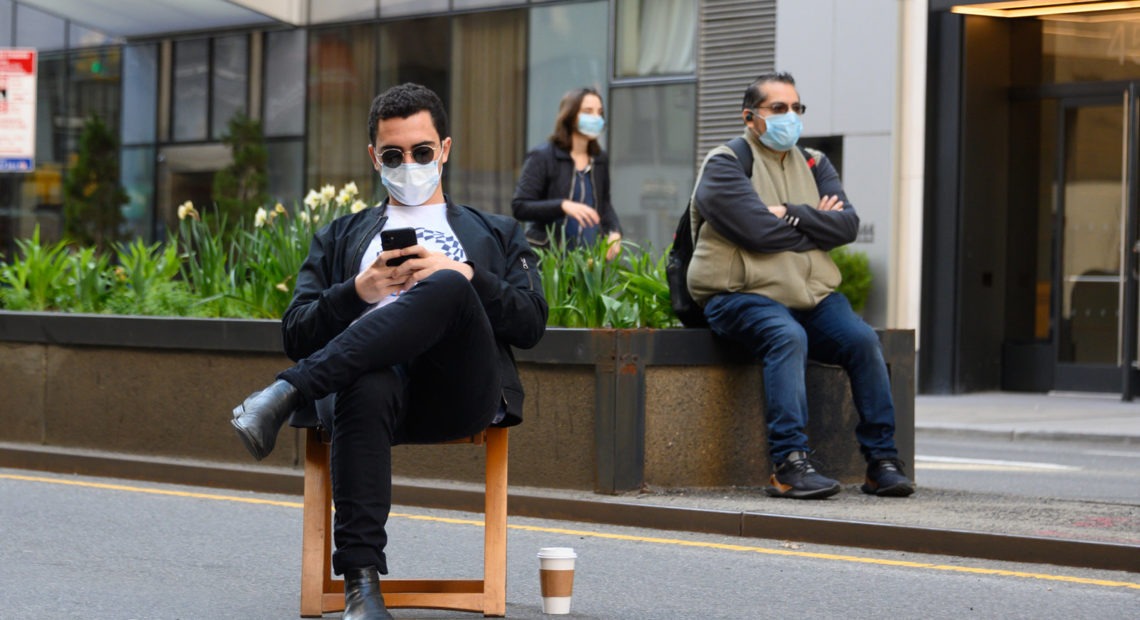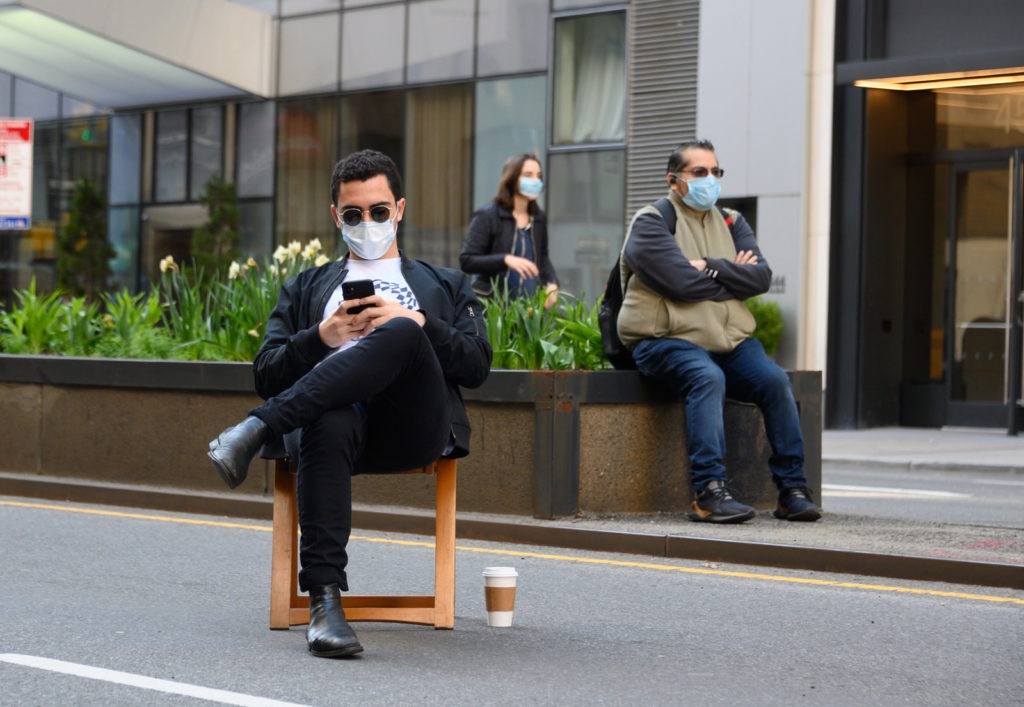
Coronavirus FAQs: Is A Homemade Mask Effective? And What’s The Best Way To Wear One?
Since the beginning of the global coronavirus pandemic, Americans have been told by the Centers for Disease Control and Prevention not to wear masks unless they are sick, caring for a sick person who is unable to wear one or working in health care.
Numerous reasons have been given: That they don’t offer significant protection from germs. That the most effective models need special fitting in order to work. That regular people don’t typically wear them correctly. That they’ll give people a false sense of security and cause them to be lax about hand-washing and social distancing.
And most of all: that there aren’t enough masks and respirators for the health-care workers who desperately need them so leave the masks to them.
Now there are big changes to that policy.
The Trump administration announced Friday that the CDC is now recommending people consider wearing cloth face coverings in public settings where other social distancing measures are difficult to maintain. Mayors in New York City and Los Angeles have already offered similar advice to citizens.

New Yorkers on Manhattan’s Park Avenue cover their faces last week. CREDIT: Noam Galai/Getty Images
There’s one big reason for the change: There is increasing evidence that the virus can be spread by presymptomatic and asymptomatic carriers.
These new policies come with the vital plea that people don’t use the medical-grade masks that are in short supply in hospitals right now. That means one thing: The era of the homemade masks and face-coverings is upon us.
With this new attitude come many questions — which we’ll attempt to answer here.
Can face coverings prevent the spread of the virus?
The primary benefit of covering your nose and mouth is that you protect others. While there is still much to be learned about the novel coronavirus, it appears that many people who are infected are shedding the virus – through coughs, sneezes and other respiratory droplets – for 48 hours before they start feeling sick. And others who have the virus – up to 25%, according to Centers for Disease Control and Prevention Director Dr. Robert Redfield — may never feel symptoms but may still play a role in transmitting it.
That’s why wearing a mask even if you don’t feel sick can be a good idea.
If you cough or sneeze, the mask can catch those respiratory droplets so they don’t land on other people or surfaces. “So it’s not going to protect you, but it is going to protect your neighbor,” says Dr. Daniel Griffin at Columbia University, an expert on infectious diseases. “If your neighbor is wearing a mask and the same thing happens, they’re going to protect you. So masks worn properly have the potential to benefit people.”
The best masks are N95 respirators, but the general public is urged not to use them because they are fiercely needed by health care workers right now. If you have those, consider donating them immediately to a local hospital or find a drop-off here. Same goes for surgical masks — those thin blue models– which offer less protection but are helpful and are also in short supply.
If I’m wearing a mask and someone sneezes on me, would the mask offer some protection?
Yes. But only if you use the mask properly and don’t touch it with your hands afterward.
Those droplets from a cough or sneeze would hit your mask instead of your mouth and nose — good news. But the next step is to take the mask off by the ear bands and either wash or discard it – without touching the front of it.
“That’s what I see all the time,” says Griffin. “That’s why in the studies masks fail — people don’t use them [correctly]. They touch the front of it. They adjust it. They push it down somehow to get their nose stuck out.”
If you touch the front of the mask, whatever that person coughed or sneezed on it is now on your hands.
As this video from the World Health Organization shows, you should take off your mask by removing the elastics or straps from behind your ears. Don’t touch the front, and keep the mask away from your face.
One other thing: Ideally you’d have eye protection, too, to keep that stranger’s sneeze from getting in. Glasses and sunglasses aren’t perfect but can help.
What about homemade masks?
As NPR has previously reported, some research has shown that cotton T-shirt material and tea towels might help block respiratory droplets emitting from sick people — though it’s not clear how much protection they provide.
Another study, of health care workers in Vietnam, found that use of cloth masks resulted in greater infection than either those wearing surgical masks or a control group, some of whom also wore surgical masks.
We don’t yet know exactly how effective homemade masks are, but Griffin thinks they’re a good idea — he’s even taken to wearing one over his N95 respirator.
How often do I need to wash it?
Griffin says to think of a mask as like underwear: It needs to be washed after each use.
“You don’t take this dirty mask off, put it in your purse and then stick it back on your face,” he says. “It’s something that once you put on, is potentially either touching your coughs, sneezes or the spray of your speech, or protecting you from the coughs, spray, speech of other people. And now it’s dirty. It needs to basically be either discarded or washed.”
So if you’re wearing a cloth mask, put it into the laundry basket immediately. If it’s disposable, throw it away.
It’s a big no-no to pull the mask down to eat a snack, then pull it back up: You’ve just gotten whatever dirty stuff is on the mask on your hands and into your mouth.
Is there one best mask design?
There is little data so far on cloth or homemade masks in general — let alone data that dictates how many pleats to put on your home-sewn version.
Griffin says the best material to use is a tight-weave cotton. “Don’t use a synthetic or a polyester because they’ve looked at the virus’s ability to survive on surfaces, and spandex is the worst,” he says.
Johns Hopkins Medicine has one design you might try. Kaiser Permanente has another design, as well as a video showing how to make a mask using a sewing machine. Both recommend 100% woven cotton fabric. Kaiser recommends washing and drying the fabric two or three times before cutting it, so it doesn’t shrink later.
You can make a mask out of a t-shirt, no sewing machine required. You could also try making one out of (unused) shop towels. But no matter what you make it out of, try to make it fit closely to your face and don’t touch the front of it once you’ve started wearing it.
If you use cloth masks, make a number of them so you can wear a fresh one each time you go out.
Would a scarf work?
Probably not as well as a mask that fits closely to your face.
“You can imagine if you put a loosely knit scarf with lots of holes in it … that would not be very effective,” says Dr. Michael Klompas, an infectious disease physician at Brigham and Women’s Hospital.
The goal is to create a barrier that catches droplets and keeps others from coming in, so you want coverage that is tightly woven and close-fitting.
Can I donate masks to hospitals?
After you get a handle on making masks, you could keep going – and donate the additional masks to health care centers. Johns Hopkins University, for instance, is accepting donated masks for non-patient care settings. It asks that masks not be made in a solid color, especially blue or white, which could be confused with medical-grade masks.
Do masks confer any other benefits?
Masks can also function as an important visual cue, says Joseph Allen, a professor of exposure and assessment science at Harvard University T.H. Chan School of Public Health.
They’re a “reminder that we need to be taking these precautions and serve as a reminder to people to keep that six foot buffer,” he says. “It should be seen as a badge of honor. If I’m wearing a mask out in public, it means I’m concerned about you, I’m concerned about my neighbors, I’m concerned about strangers on the chance that I’m infectious. I want to do my part in limiting how I might impact you.”
Klompas agrees — and says that it can also give the wearer a welcome sense of security.
“It feels like you’re behind a shield,” he says, “and I think that in itself can be reassuring.”
And for the others around you, it’s a warning. “It says: Watch out. There’s a public health crisis right now, there’s a virus going around, we need to be on top guard,” says Klompas. “I think it can actually be a reinforcer, a reminder of the state of crisis that we face in society.”
But he says that masks are not a replacement for all the other steps we need to take right now to protect ourselves from the coronavirus – especially social distancing and good hand hygiene.
Copyright 2020 NPR. To see more, visit npr.org















